Charger Xtar VC2S
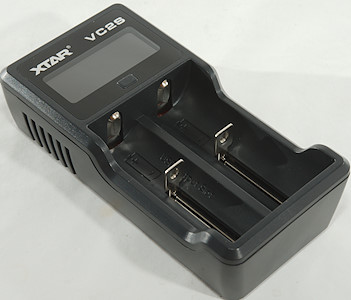
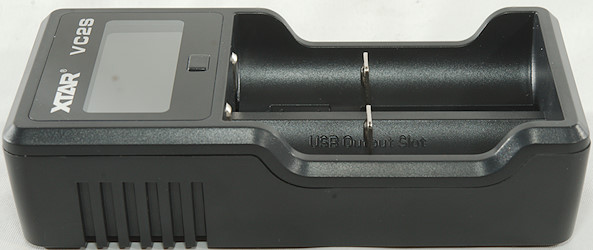
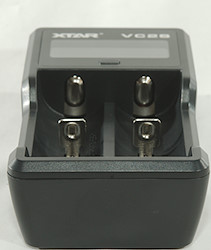
Xtar makes many chargers, this is a usb powered dual channel charger with display. The charger can charge with up to 2A for a channel, the current will depend on the internal resistance in the batteries. It can also work as a power bank.
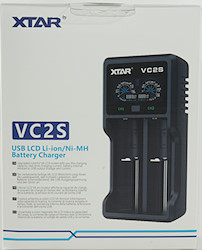



I got the charger in cardboard box with the specifications printed on it.
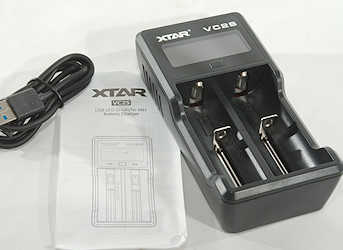
n the box was the charger, a usb cable and a instruction sheet in many languages.
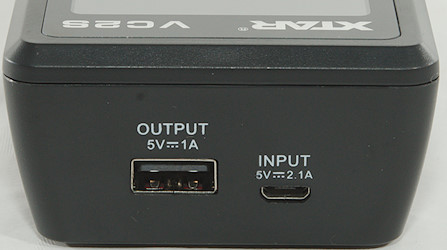
The charger is usb powered from a micro usb connector and it has a power bank output.
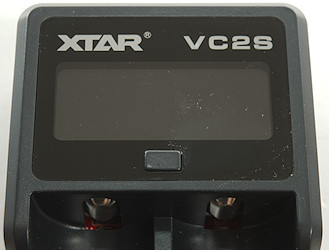
The user interface is a display, two leds and one button to select what the display shows or turn on the usb output.
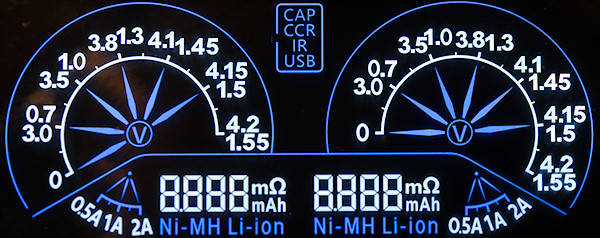
When powered on the display will show all segments, the needle will start from zero and increase, I took the photo before the last needle was displayed.
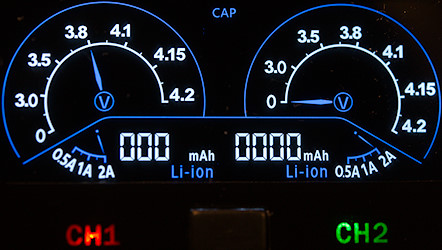
Charging one battery, the red/green leds always make it easy to see if the charger is finished.
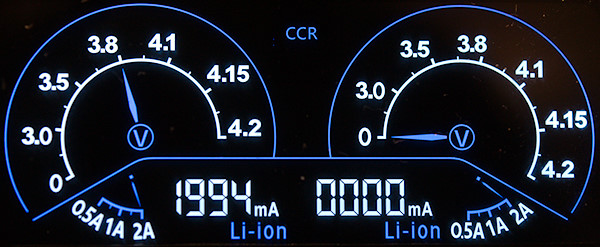
One press on the the button and the display shows the actual charge current.
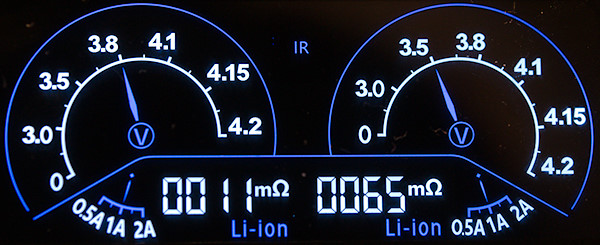
After next press it shows the internal resistance in the batteries.
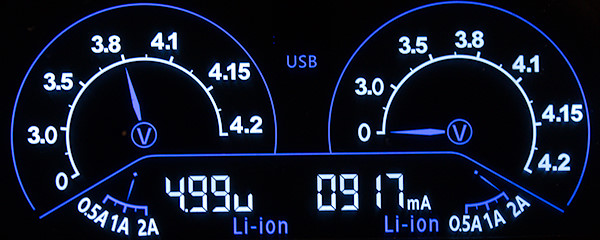
When used as a power bank the display shows the usb voltage and current.

The specifications are on the back of the charger, but you need light from the right angle to read it and maybe a magnifying glass.


The charger can handle both button top and flat top batteries.
The slider moves smoothly and can hand cells from 30mm to 70.5mm long.
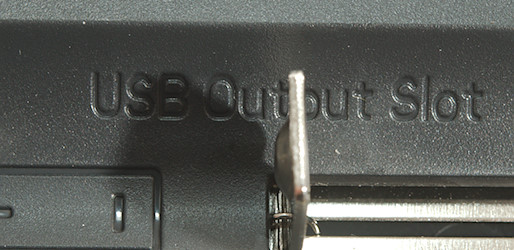
The power bank function only uses one battery and the slot is marked.


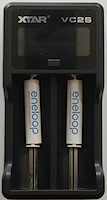
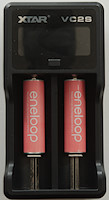
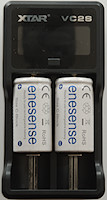
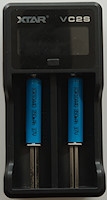
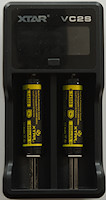
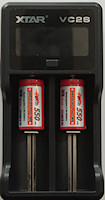
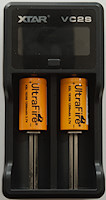
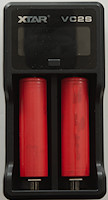
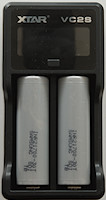
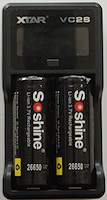
The charger can handle 71 mm long batteries, including flat top cells.
The current for 10440 is on the high side even with the automatic regulation at minimum.
Measurements charger
- Charger will use about 145mA from usb with display at full brightness and 32mA with display at low brightness.
- When charging the last digit in the capacity displays will flash.
- The charger will assume NiMH from 0V to 1.7V
- From 1.8V the charger will assume LiIon
- When charge is finished the charger will charge with 0.5mA for LiIon.
- Charger will restart if voltage drops to 3.9 volt.
- Charge will restart charging after power loss, or battery insertion.
- When not connected to power it will drain about 1mA from a LiIon battery and 0.2mA from a NiMH battery.
- Voltage dial will update after the charging is done.
- Voltage dial is not very precise.
- Charge current steps down if usb voltage drops too much and may step up if usb voltage recovers (Like when one slot is finished).
- mAh display flashes "Full" when the corresponding battery is full.
Charging 4.2V LiIon
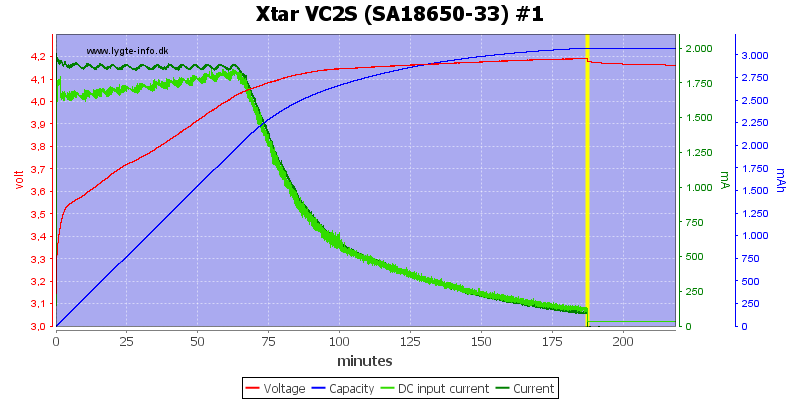
This is a nice CC/CV charge curve with a termination around 100mA. The mAh display is rather optimistic.
Display shows 3437mAh 42mOhm
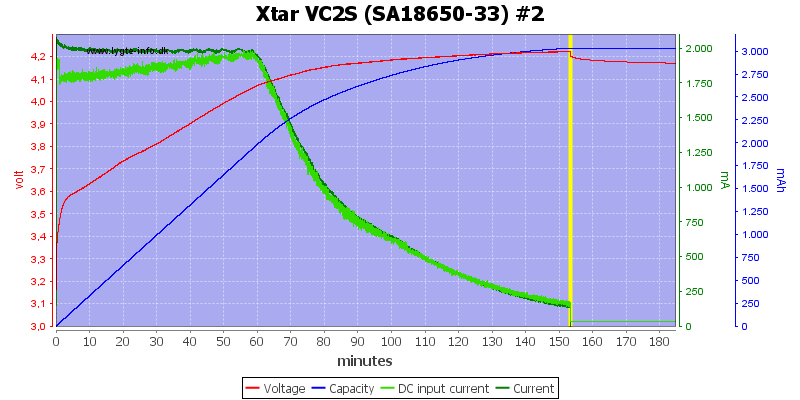
Here the voltage is slightly higher and the termination is around 140mA
Display shows 3107mAh 47mOhm
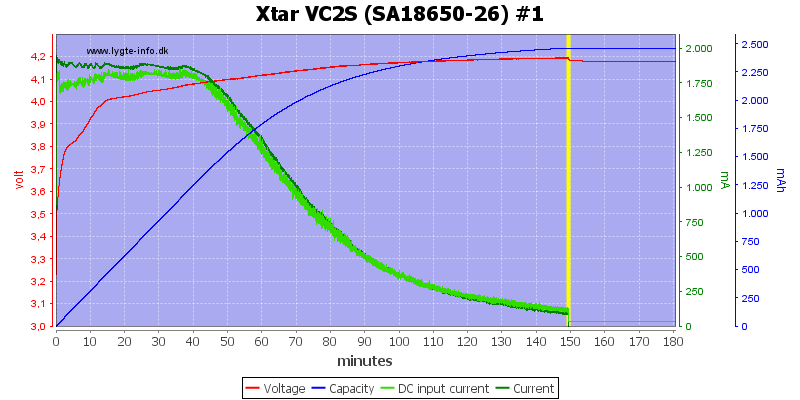
The 2600mAh battery looks similar
Display shows 2730mAh 50mOhm (Discharge test shows 2481mAh was charged into battery)
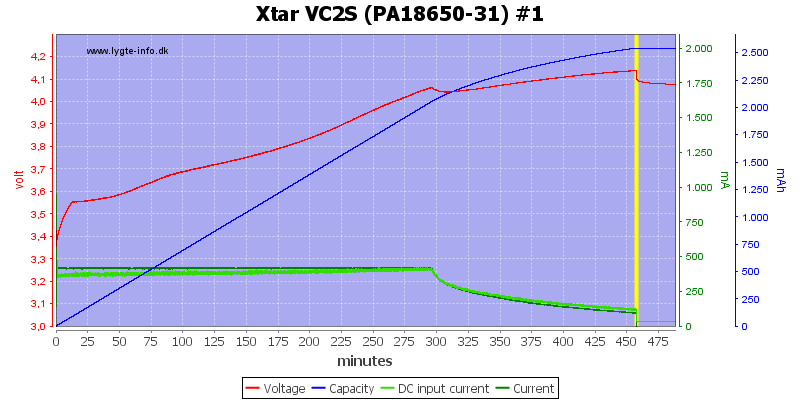
This battery is older and has higher internal resistance, the charger reduces charge current.
Display shows 3214mAh 179mOhm
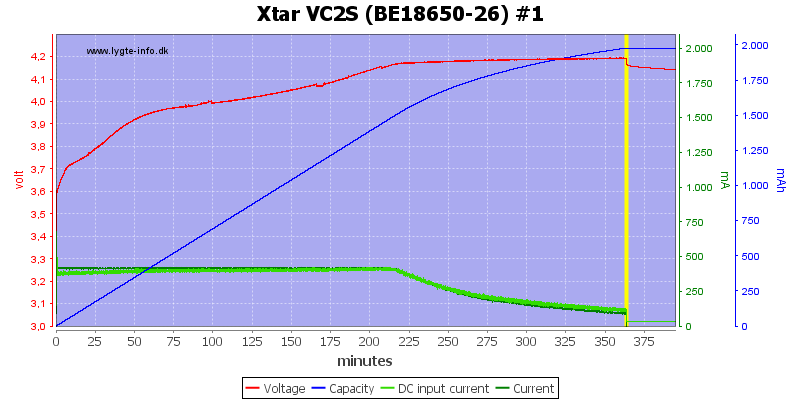
It is the same with this battery.
Display shows 2515mAh 149mOhm
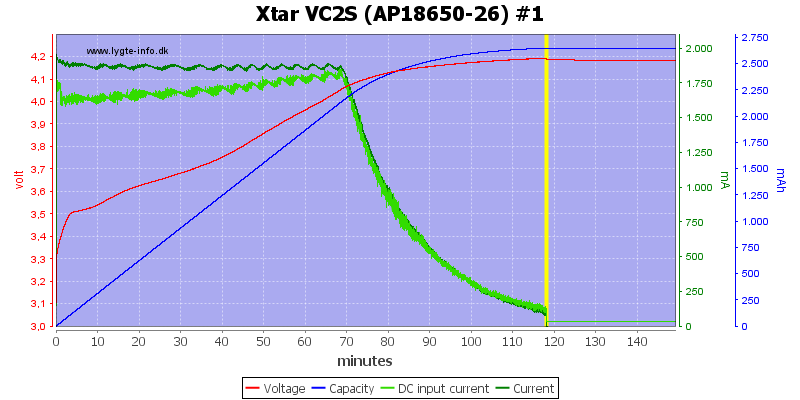
This is a new 2600mAh high current battery and it is charged at 2A.
Display shows 2902mAh 50mOhm

This larger cell is also charged at 2A
Display shows 3164mAh 20mOhm
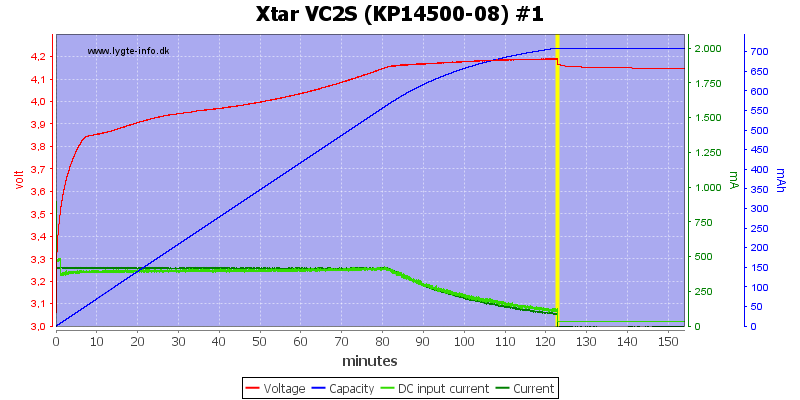
A 14500 cells is charged at low current.
Display shows 889mAh 146mOhm
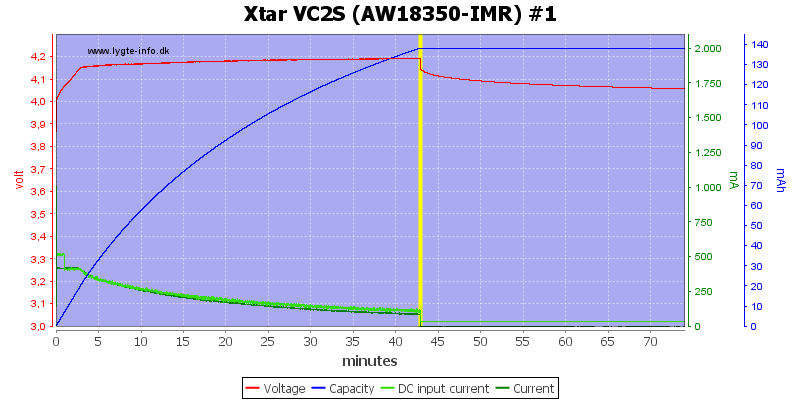
The same for my worn down 18350 cell.
Display shows 204mAh 146mOhm
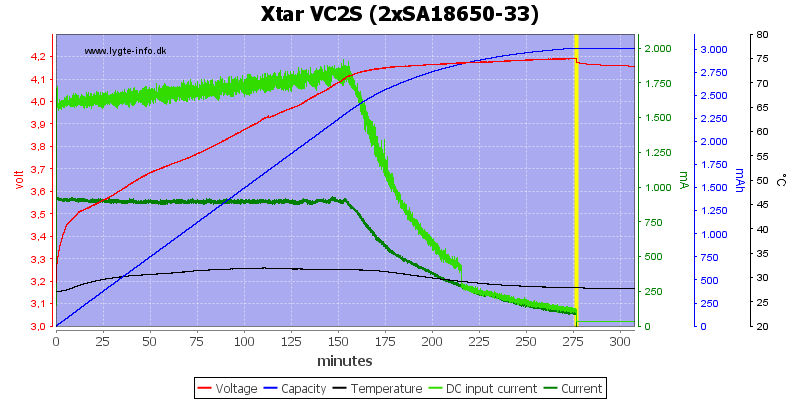
With two batteries in the charger the current is reduced to 1A for each cell.
Display shows 3489mAh 63mOhm and 3112mAh 41mOhm

Adding 0.5ohm in series with the power supply forced the charger to reduce the current, but the measurement circuit is affect by this resistor, the cell is not 4000mA or 5mOhm.
Display shows 4074mAh 5mOhm and 3456mAh 5mOhm
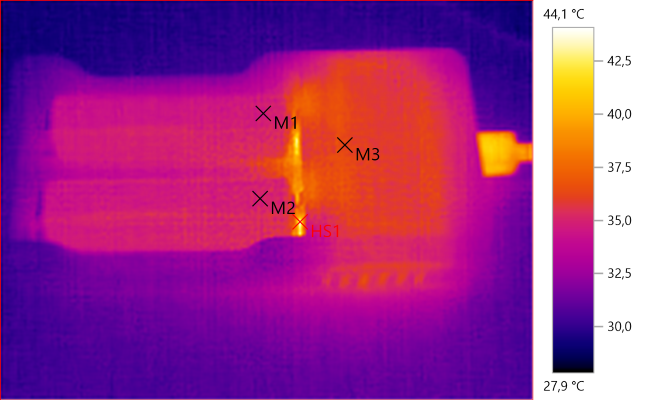
M1: 34.6°C, M2: 35.0°C, M3: 36.1°C, HS1: 44.1°C
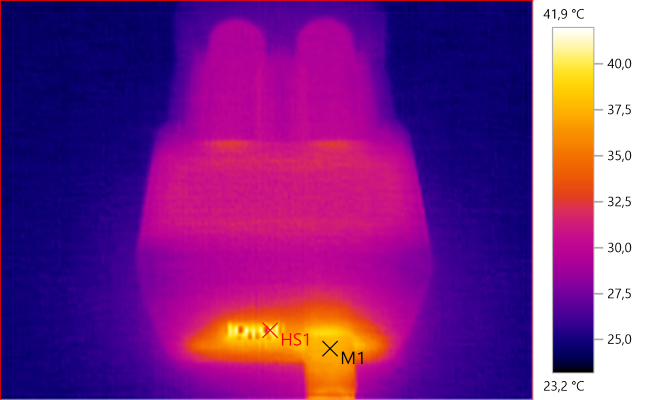
M1: 37.5°C, HS1: 41.9°C
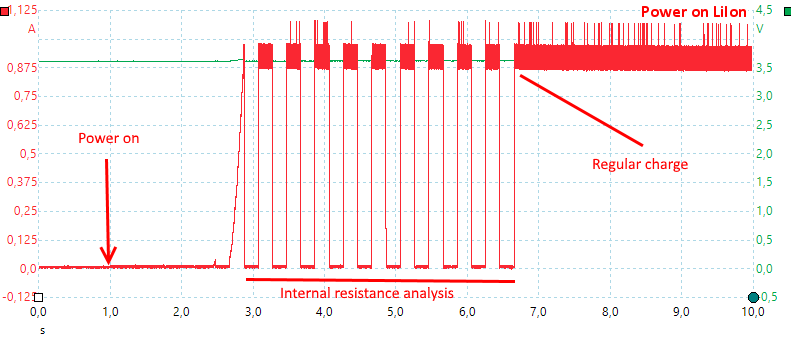
The charger pulses the charger current when starting a charge, this is used to analyse the internal resistance.
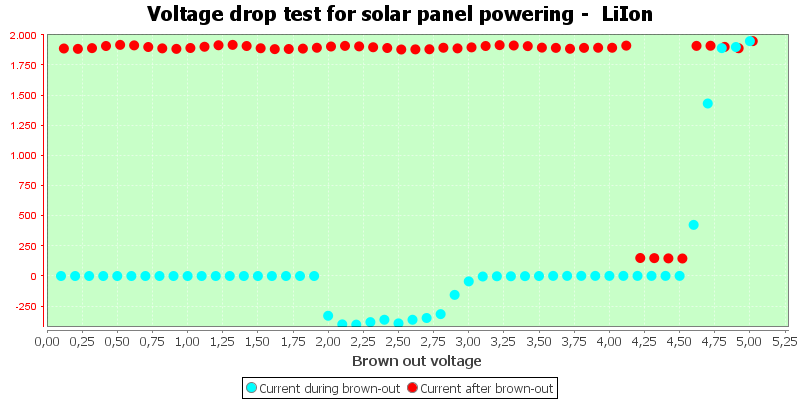
This charger has two problems with unstable supply voltage, it may lockup and it may discharge the batteries. Between 2V and 3V input voltage it will back feed current to the input and if something else is using power from the panel it will drain the batteries.
Charging NiMH
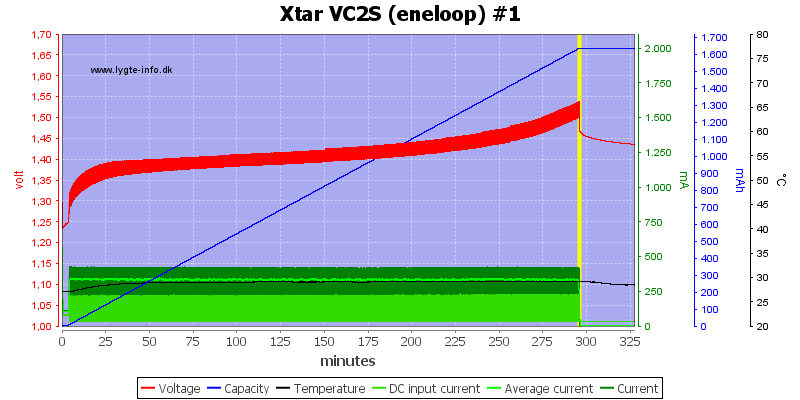
My eneloop has been used a lot and the internal resistance is a bit high, this means the charger uses a low charge current. It looks like the termination is on voltage and a bit before the cell is full.
Display shows 1851mAh 103mOhm

The second channel is the same.
Display shows 1538mAh 125mOhm

The eneloop pro is also the same.
Display shows 2403mAh 82mOhm
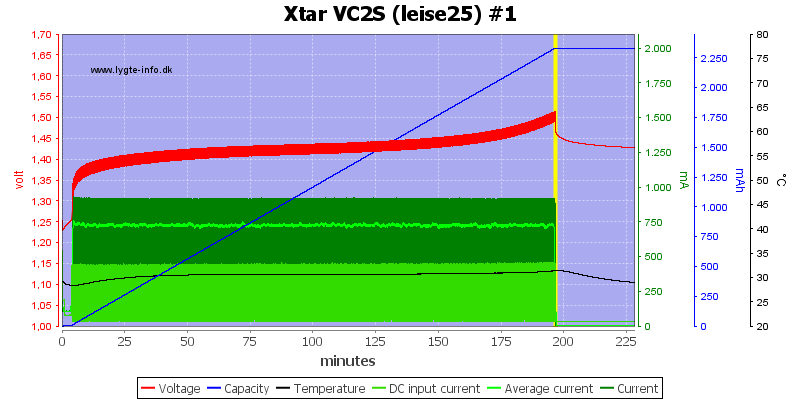
The Leise battery needs slightly lower voltage to be full and termination works much better here (A small temperature increase can be seen on the black line).
Display shows 2438mAh 67mOhm
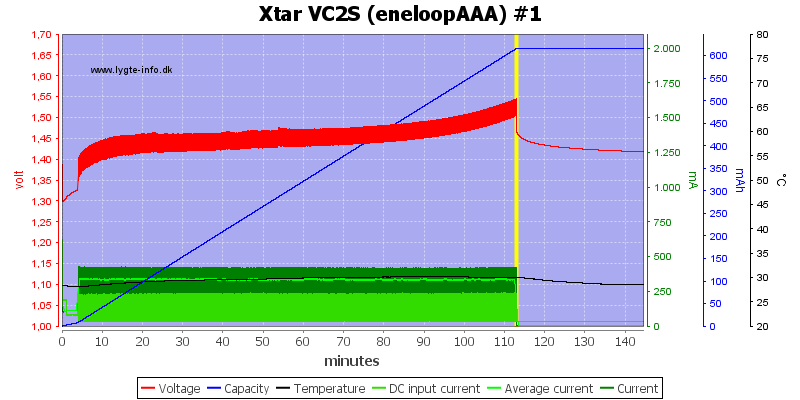
The AAA cell also stops a bit before it is full.
Display shows 700mAh 202mOhm
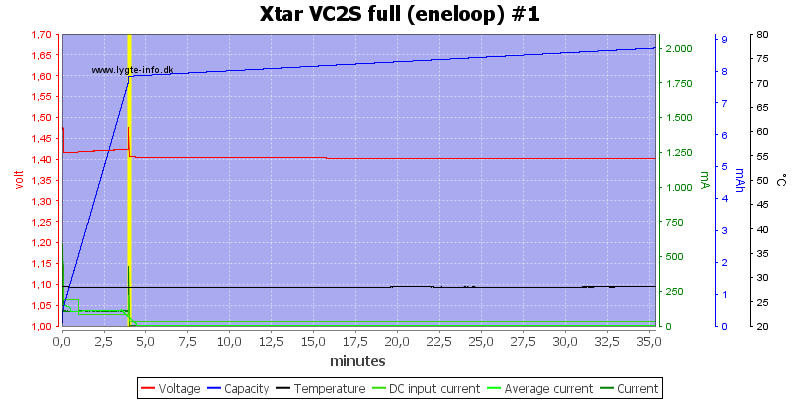
Due to the voltage termination the charger is fast at detecting a full cell, it happens when it switches to full charge current.
Display shows 13mAh 81mOhm
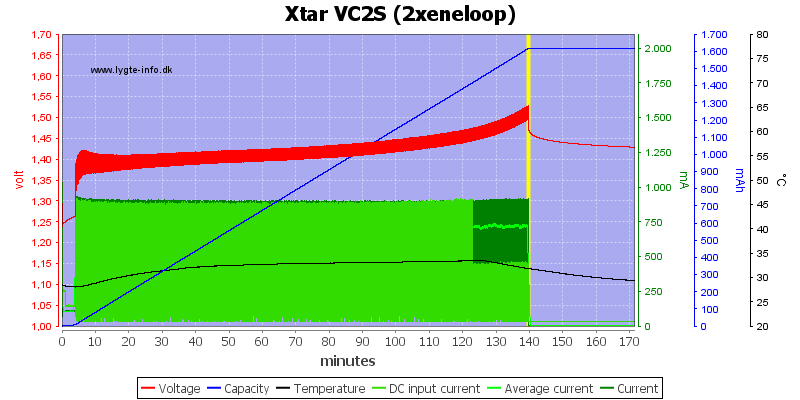
The charger can handle two cells simultaneous.
Display shows 1719mAh 76mOhm and 1506mAh 73mOhm
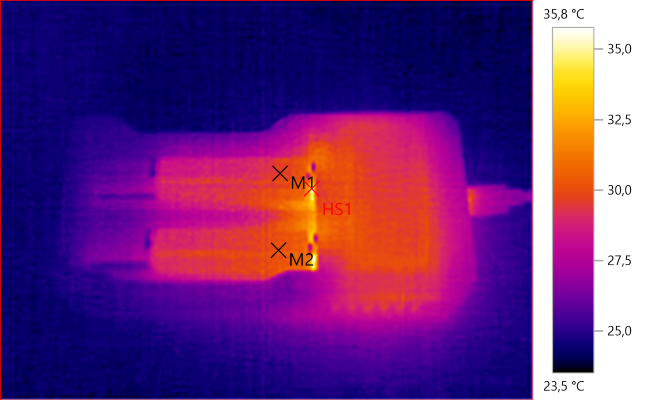
M1: 29.6°C, M2: 30.1°C, HS1: 35.8°C
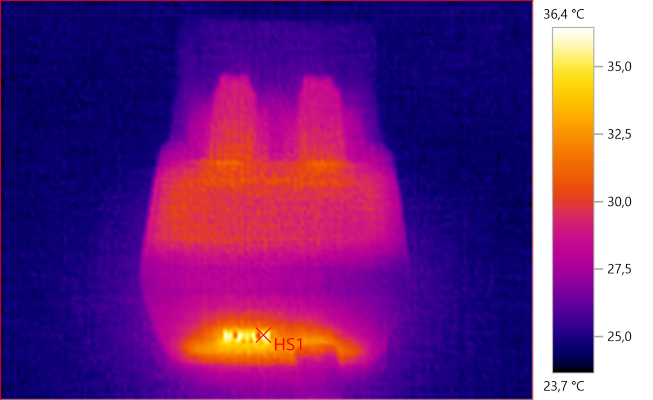
HS1: 36.4°C
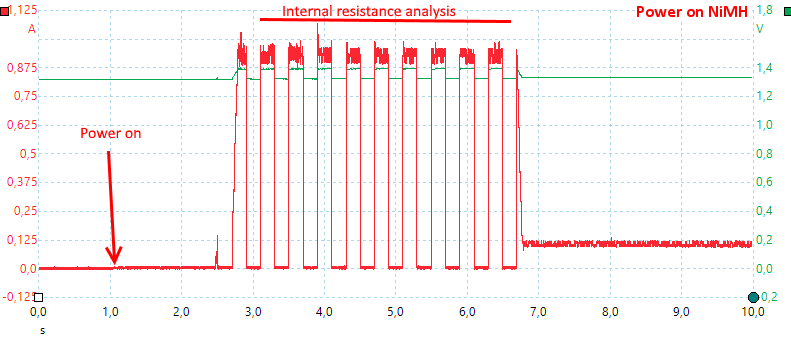
This looks similar to LiIon, but the charge current is very low.
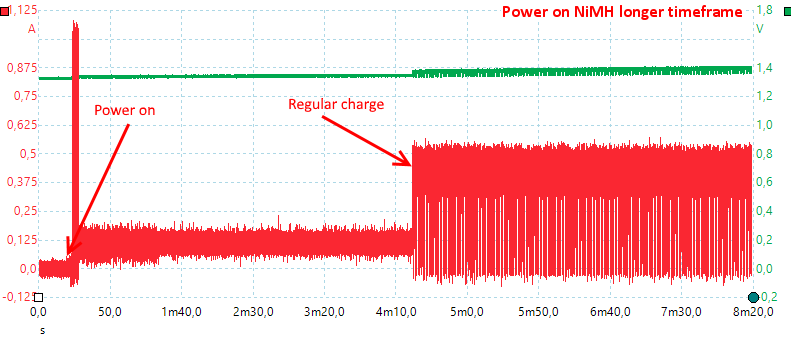
Using a longer timescale it can be seen that the charger switches to full charge current after about 4 minutes.
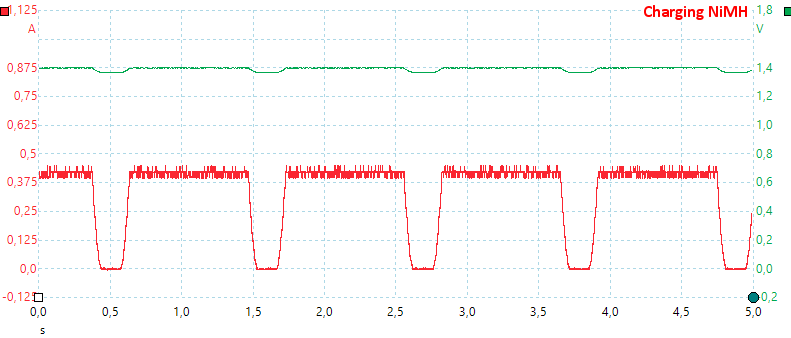
As usual the charge current is turned off at regular intervals to check charge voltage when charging NiMH.
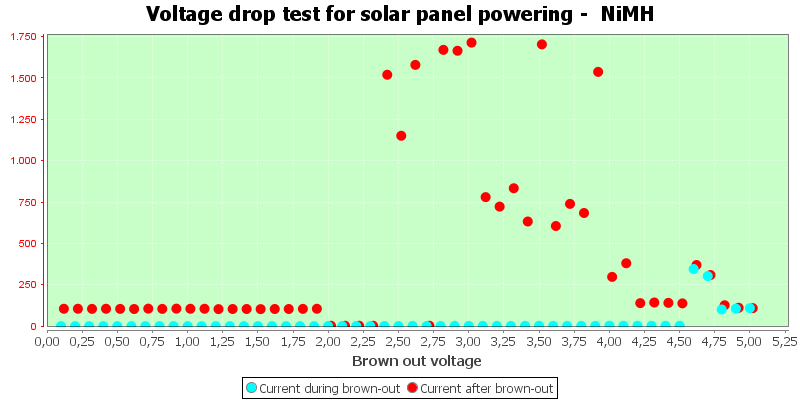
Because the charger uses a low current for about 4 minutes, I do not register the full charge current, the high current is because the charger fails in selecting the correct current when voltage changes. It did also fail to recover if some of the voltage dives.
Internal resistance

I wonder about the difference between the two channels, they are not calibrated the same when checking LiIon.
The actual measurement circuit is very consistent, but will give a too low value.

With the NiMH both channels gives similar value. Again the measurement circuit is very consistent, but actual value is too low.
USB output (Power bank)
- USB voltmeter looks precise
- When not connected to power it will drain about 1mA from a LiIon battery
- Usual usb output will turn on automatic, and it can be forced with the switch.
- Usb output is coded as USB charger (DCP)
- Usb output will turn off after 40 seconds with less than 220mAh load.
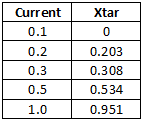
When using the usb output the current is shown, it is not a super precise meter, but gives an good idea about the current draw.
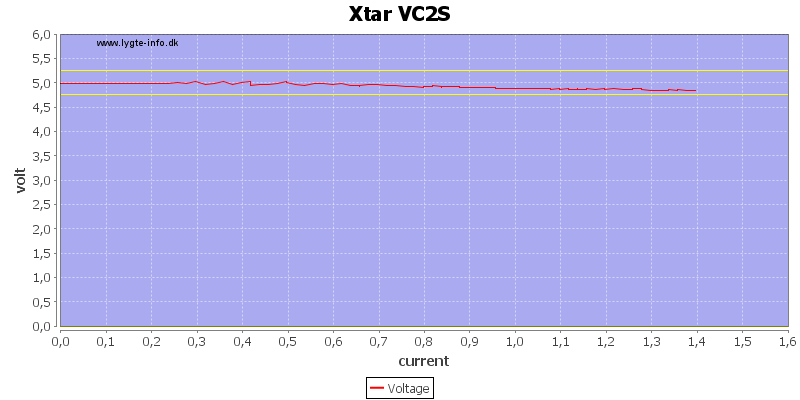
The power bank function is rated for 1A and can deliver about 1.4A with a full battery.
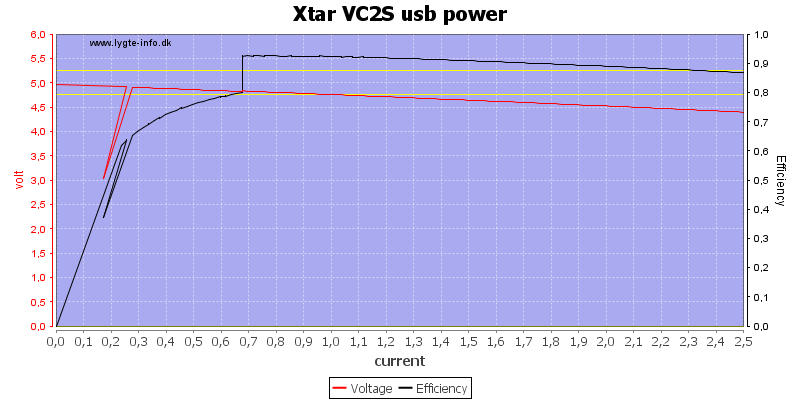
The usb output can also deliver current directly from the usb input, but there is no current limit (I stopped manually at 2.5A).
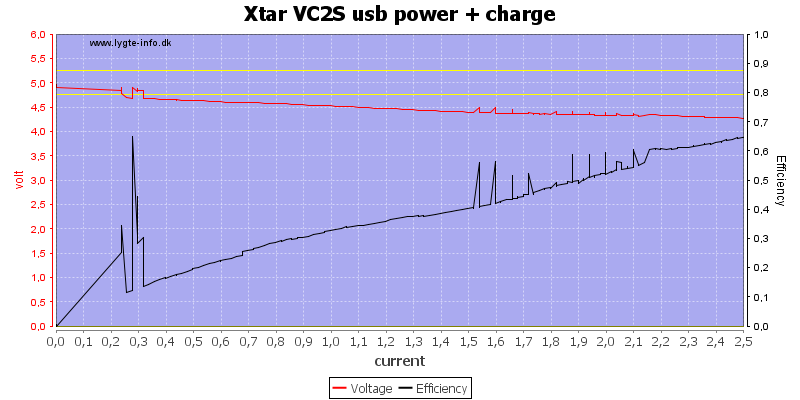
Here I charge a battery at the same time and was drawing about 3.3A from the usb supply.
Efficiency will be low, because some of the energy is used to charge the battery, not for usb output.
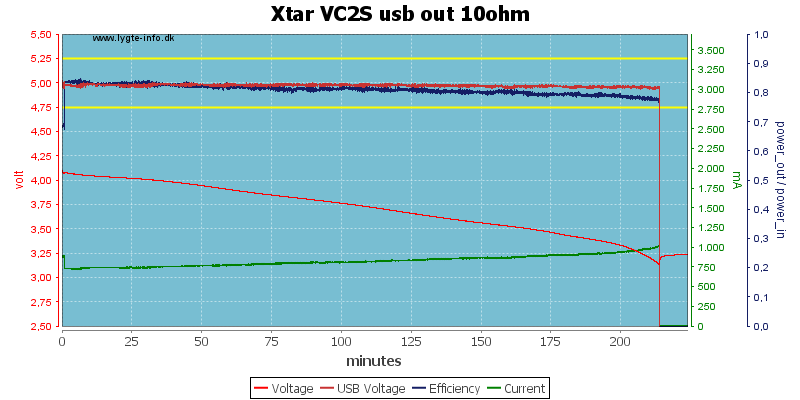
Running the power bank with a 0.5A load it can maintain the output for about 3½ hours.
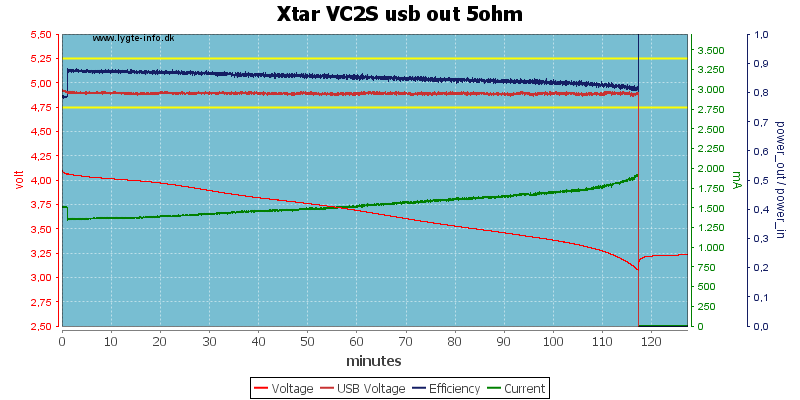
At 1A the output is maintained about 2 hours, again with full voltage until the battery is empty.
The jump in efficiency at the start is when the display reduces background light.

Noises is 47mV rms and 339mVpp

Noises is 45mV rms and 360mVpp
Conclusion
The charger is good at charging LiIon, with NiMH it uses voltage termination without top-off charge and that means the batteries is charged slightly below full capacity.
The automatic current selection means that charge current is kept down at a fairly safe level.
This charger has a calibration problem on slot #1 for the mAh measurement, it shows way to much.
The usb output works fine and the display is nice, using only one cell means the output current is a bit on the low side.
I will rate it as fairly good.
Notes
The charger was supplied by XTAR for a review.
Here is an explanation on how I did the above charge curves: How do I test a charger




































































